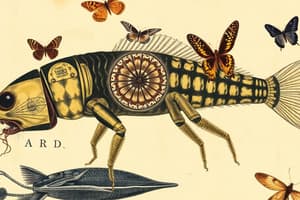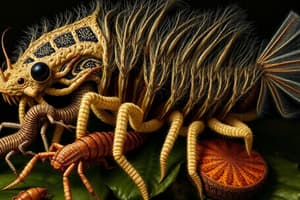Podcast
Questions and Answers
What is NOT a threat to invertebrate populations?
What is NOT a threat to invertebrate populations?
- Overexploitation for food and other resources
- Habitat loss due to deforestation and urbanization
- Pollution from industrial sources
- Increased biodiversity (correct)
Which of these statements accurately describes the importance of invertebrates?
Which of these statements accurately describes the importance of invertebrates?
- Invertebrates play a crucial role in nutrient cycling and food webs, providing food for other animals and humans. (correct)
- Invertebrates are only important to the food chain, not to humans.
- Invertebrates are only beneficial for ecosystems and do not contribute to research or human food sources.
- Invertebrates have no economic or scientific value.
What is a key benefit of invertebrate conservation efforts?
What is a key benefit of invertebrate conservation efforts?
- Ensuring the continued abundance of specific species for human consumption.
- Maintaining the stability and health of ecosystems. (correct)
- Reducing the impact of invasive species on ecosystems.
- Preventing the spread of diseases carried by invertebrates.
Which of the following is NOT a conservation effort for invertebrates?
Which of the following is NOT a conservation effort for invertebrates?
What does the statement "Different groups have distinct evolutionary paths" suggest about invertebrates?
What does the statement "Different groups have distinct evolutionary paths" suggest about invertebrates?
Which phylum is characterized by simple multicellular organisms with porous bodies?
Which phylum is characterized by simple multicellular organisms with porous bodies?
Invertebrates with bilateral symmetry exhibit which of the following characteristics?
Invertebrates with bilateral symmetry exhibit which of the following characteristics?
Which invertebrate phylum is known for having jointed appendages?
Which invertebrate phylum is known for having jointed appendages?
What key characteristic is primarily used to distinguish between Protostomes and Deuterostomes?
What key characteristic is primarily used to distinguish between Protostomes and Deuterostomes?
Which of the following invertebrate groups is recognized for having a complex water vascular system?
Which of the following invertebrate groups is recognized for having a complex water vascular system?
Annelids are known for which of the following features?
Annelids are known for which of the following features?
Which of the following correctly describes a unique feature of Nematoda?
Which of the following correctly describes a unique feature of Nematoda?
Which type of body cavity is characteristic of the Acoelomate organisms?
Which type of body cavity is characteristic of the Acoelomate organisms?
Flashcards
Nutrient cycling
Nutrient cycling
The process by which organisms break down dead matter, releasing nutrients back into the ecosystem.
Food web
Food web
A complex network of feeding relationships between organisms in an ecosystem.
Food source for other animals
Food source for other animals
Invertebrates play a crucial role in providing food for other animals, contributing to the overall ecosystem.
Threats to invertebrates
Threats to invertebrates
Signup and view all the flashcards
Conservation efforts for invertebrates
Conservation efforts for invertebrates
Signup and view all the flashcards
Invertebrates
Invertebrates
Signup and view all the flashcards
Porifera (Sponges)
Porifera (Sponges)
Signup and view all the flashcards
Cnidaria (Jellyfish, Corals, Anemones)
Cnidaria (Jellyfish, Corals, Anemones)
Signup and view all the flashcards
Platyhelminthes (Flatworms)
Platyhelminthes (Flatworms)
Signup and view all the flashcards
Nematoda (Roundworms)
Nematoda (Roundworms)
Signup and view all the flashcards
Mollusca (Snails, Clams, Oysters)
Mollusca (Snails, Clams, Oysters)
Signup and view all the flashcards
Annelida (Segmented Worms)
Annelida (Segmented Worms)
Signup and view all the flashcards
Arthropoda (Insects, Spiders, Crustaceans)
Arthropoda (Insects, Spiders, Crustaceans)
Signup and view all the flashcards
Study Notes
Introduction to Invertebrates
- Invertebrates are animals without a backbone or spinal column.
- They represent the vast majority of animal species on Earth.
- They exhibit a remarkable diversity of forms, habitats, and life strategies.
- These animals display a range of adaptations to diverse environments.
Major Invertebrate Phyla
- Porifera (Sponges): Simple, multicellular organisms with porous bodies; lack true tissues and organs; filter feeders.
- Cnidaria (Jellyfish, Corals, Anemones): Radial symmetry, stinging cells (cnidocytes); simple body structures, often with a gastrovascular cavity.
- Platyhelminthes (Flatworms): Bilateral symmetry; flattened body shape; simple digestive system (or no digestive system in some).
- Nematoda (Roundworms): Cylindrical, unsegmented bodies; found in virtually every environment; pivotal roles in nutrient cycling.
- Mollusca (Snails, Clams, Oysters): Soft body often covered by a hard shell; muscular foot for locomotion; mantle secretes the shell.
- Annelida (Segmented Worms): Segmented bodies; segmentation allows for greater flexibility and specialization of body parts.
- Arthropoda (Insects, Spiders, Crustaceans): Largest phylum; segmented bodies, jointed appendages, exoskeleton; remarkable diversity.
- Echinodermata (Starfish, Sea Urchins, Sea Cucumbers): Radial symmetry as adults, bilateral symmetry during development; unique water vascular system for locomotion and feeding.
Key Characteristics Influencing Classification
- Body symmetry (radial, bilateral).
- Presence or absence of tissues, organs, and organ systems.
- Body cavity types (acoelomate, pseudocoelomate, coelomate).
- Patterns of development (protostome, deuterostome).
- Digestive systems (complete, incomplete).
- Presence or absence of a circulatory system.
- Respiratory mechanisms.
- Nervous system structure.
- Presence of exoskeletons or endoskeletons.
Invertebrate Diversity and Ecological Roles
- Invertebrates play crucial roles in many ecosystems.
- They are primary consumers, decomposers, and predators.
- They contribute to nutrient cycling and food webs.
- They provide a significant food source for other animals.
Evolutionary History of Invertebrates
- The evolutionary history of invertebrates is rich and complex.
- Different groups have distinct evolutionary paths.
- Evolutionary adaptations have shaped their body plans and functional characteristics.
Importance to Humans
- Invertebrates are important in various fields, including food, research, and the ecosystem.
- They are a major source of food for humans in some parts of the world.
- They are used extensively in biomedical research.
- Maintaining healthy invertebrate populations is crucial for ecosystem stability.
Threats to Invertebrates
- Habitat loss and degradation (deforestation, urbanization).
- Pollution.
- Climate change impacts.
- Overexploitation for food and other resources.
Conservation Efforts
- Efforts to conserve invertebrate populations are gaining recognition.
- Protecting habitats and promoting sustainable practices.
- Monitoring and researching species to understand population trends and challenges.
- Educating the public about the importance of invertebrates.
Studying That Suits You
Use AI to generate personalized quizzes and flashcards to suit your learning preferences.




